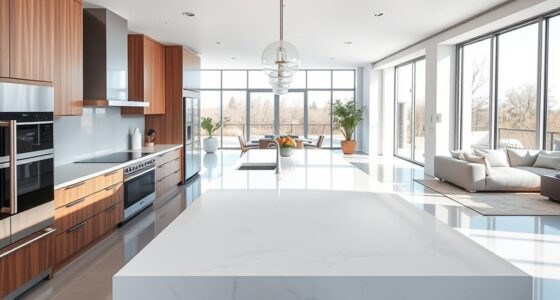Modular furniture systems offer you unmatched flexibility, letting you easily reconfigure your space to fit changing needs while maximizing style and functionality. By using interchangeable modules, durable materials, and smart features like embedded technology, you can create versatile layouts for small apartments, offices, or social areas. These systems are designed for quick, effortless adjustments, saving you money and space. Continue exploring to discover how you can transform your environment with innovative modular solutions.
Key Takeaways
- Modular furniture features interchangeable components for easy reconfiguration to suit changing space needs.
- Advanced materials and smart integration enhance adaptability and user customization options.
- Versatile components like movable partitions and stackable units optimize space utilization efficiently.
- Reconfiguration strategies save costs, time, and effort by allowing upgrades without full replacements.
- Future trends include embedded sensors and smart automation to enhance flexibility and environmental control.
The Evolution of Modular Furniture Design

The evolution of modular furniture design reflects a continuous effort to combine flexibility with functionality. Over time, designers have shifted from bulky, static pieces to sleek, adaptable systems that suit diverse needs. You’ve likely noticed how early modular pieces focused on basic configurations, but now, they incorporate advanced materials and smart features. This progression responds to changing lifestyles, emphasizing ease of customization and space optimization. As technology advances, modular furniture becomes more intuitive, allowing you to effortlessly reconfigure your space. Incorporating innovative materials further enhances durability and aesthetic appeal. The goal remains clear: create versatile solutions that grow with your needs, whether in small apartments or expansive offices. This ongoing development keeps modular furniture relevant, ensuring it continues to enhance your environment seamlessly.
Key Components of Modular Systems

You’ll find that interchangeable modules are at the heart of modular furniture, allowing you to reconfigure pieces easily. These designs offer a variety of options, so you can customize setups to fit your space and style. By understanding these key components, you can create versatile and personalized furniture solutions. Incorporating flexible design principles ensures your furniture adapts seamlessly to changing needs and preferences.
Interchangeable Modules Design
Interchangeable modules form the core of flexible modular furniture systems, enabling you to customize and reconfigure your furniture with ease. These modules are designed to fit together seamlessly, often using standardized connectors or mounting mechanisms. This design allows you to swap out, add, or remove components without tools or complex procedures. The uniformity of the modules ensures compatibility across different configurations, giving you the freedom to adapt your furniture to changing needs. Whether you’re expanding a workspace or reimagining a living area, the interchangeable modules provide versatility and convenience. Their robust construction ensures stability and durability, even after multiple reconfigurations. This design philosophy puts control in your hands, making your furniture adaptable, functional, and future-proof. Additionally, understanding IRA investment strategy can help optimize your financial planning for future needs.
Customization Options Available
Customization options in modular furniture systems revolve around key components that let you tailor your setup to your specific needs. You can choose from various features to make your furniture truly yours. For example, you can select different finishes to match your decor, or add accessories like shelves and drawers for extra functionality. Adjusting the size and shape of modules allows you to optimize space and improve flow. Additionally, integrating technology or lighting options can enhance usability and ambiance. These customization options ensure your furniture adapts to your lifestyle and environment seamlessly. Whether you want a minimalist look or a more functional, multi-purpose setup, modular systems give you the flexibility to create a space that fits your unique preferences and requirements. Exploring Archives can provide inspiration and insights into the latest trends and innovations in modular furniture design.
Benefits of Choosing Modular Furniture
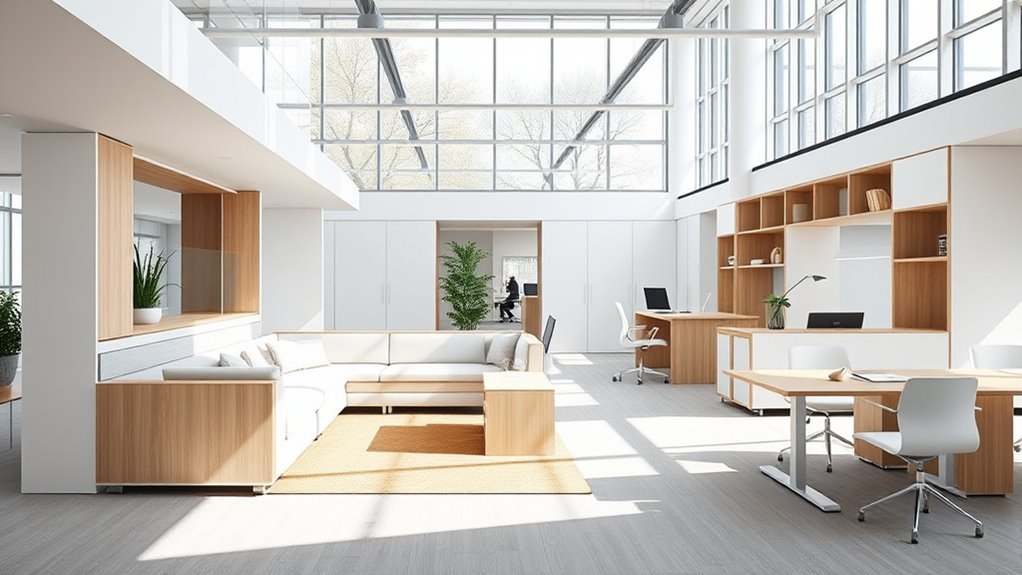
Choosing modular furniture lets you easily adapt room layouts to fit your needs. It’s cost-effective because you can upgrade or change pieces without buying entirely new furniture. Plus, reconfiguring your setup is simple, saving you time and effort whenever your space evolves. Additionally, modular systems are often designed with versatile components, making them suitable for various styles and functions.
Adaptable Room Configurations
Modular furniture offers the flexibility to easily reconfigure your space to suit changing needs. Whether you’re hosting a large gathering or need a quiet workspace, you can quickly adapt your room layout. You can transform a small area into a conference zone or create individual workstations with minimal effort. This adaptability makes your space more functional and efficient, saving you time and money. Plus, you won’t have to settle for one fixed setup that may not always serve your needs. Instead, you can experiment with different arrangements, ensuring your environment always fits your current activities. Regular tuning of your furniture arrangement can optimize space utilization and comfort.
Cost-Effective Flexibility
Because they can be easily reconfigured, modular furniture systems offer significant cost savings over traditional fixed furniture. You won’t need to buy new pieces for different layouts or purposes, saving money on replacements. Instead, you can adapt existing modules to suit changing needs, reducing long-term expenses. Modular systems also lower installation costs, since they’re quicker and simpler to set up or adjust. Maintenance becomes more affordable because individual modules can be replaced without discarding the whole setup. Additionally, their versatility means you can use the same furniture across multiple spaces or functions, maximizing your investment. Furthermore, understanding furniture options can help you choose the most suitable modular solutions for your environment. Overall, choosing modular furniture helps you stay flexible without breaking the bank, making it a smart, budget-friendly solution for dynamic environments.
Easy Reconfiguration Options
One of the key advantages of modular furniture is how easily it can be reconfigured to suit changing needs. You can quickly adapt your space without hassle, saving time and effort. Whether you need to create more seating, adjust your layout, or repurpose a room, modular pieces make it simple. You don’t need special tools or professional help—just move, add, or remove components as needed. This flexibility keeps your environment functional and visually appealing, even as your requirements evolve. Plus, it’s budget-friendly because you avoid buying entirely new furniture. With modular systems, you stay agile and responsive to your space’s demands. Residency requirements in many places influence when you can begin your reconfiguration process, ensuring that your adjustments comply with local regulations.
Creative Ways to Reconfigure Your Space
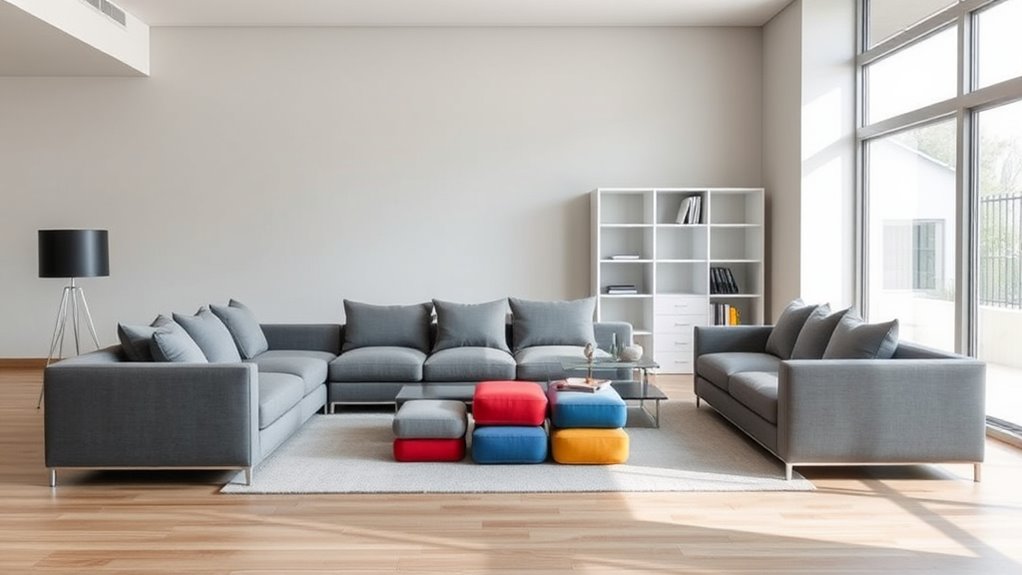
Reconfiguring your space with modular furniture opens up endless possibilities for creativity and flexibility. You can transform a small living room into a multi-functional area by rearranging sofa modules into a cozy nook or separating sections with movable partitions. Use stackable shelves to create custom storage solutions that adapt to your needs, whether for work or relaxation. Combine different pieces to form a conversation zone or a dining area, then easily reconfigure when guests arrive. Incorporate lightweight, versatile pieces that can be moved effortlessly to refresh the layout. By thinking creatively about placement and purpose, you can optimize your space for daily living, entertaining, or quiet retreat. Exploring the family influences behind furniture design can also inspire personalized arrangements that reflect your lifestyle. The key is to experiment and see how different configurations enhance your environment and suit your lifestyle.
Materials and Aesthetic Options

When choosing materials and aesthetic options for modular furniture, you have the opportunity to customize pieces that reflect your personal style and complement your space. You can select from a variety of finishes, textures, and colors to create a cohesive look. Think about durability and ease of maintenance, especially if you have kids or pets. The right materials can enhance both the functionality and appearance of your furniture. Additionally, considering material durability can ensure your furniture remains attractive and functional over time.
Tips for Selecting the Right Modular Solutions
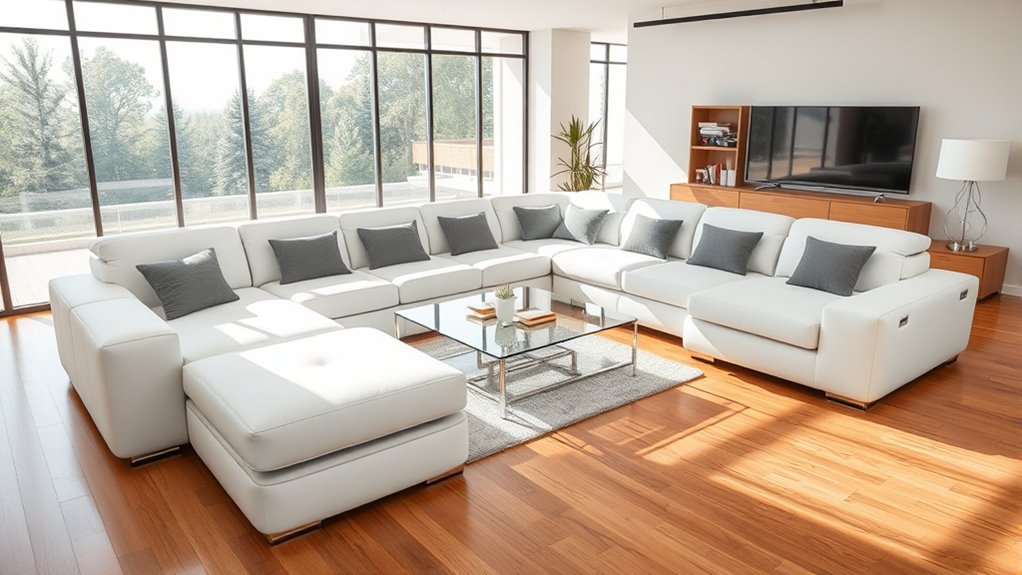
Choosing the right modular solutions starts with understanding your space and how you plan to use it. Assess your current layout, noting dimensions, traffic flow, and focal points. Identify your primary needs—whether it’s creating collaborative areas, private workstations, or flexible social zones. Prioritize versatility; look for pieces that can adapt to different functions and configurations. Consider your budget, but don’t compromise on quality, as durable modules offer better long-term value. Think about accessibility and ease of reconfiguration, so you can modify the setup as your needs evolve. Always check compatibility between modules to ensure seamless integration. Lastly, consult with suppliers or designers who can provide insights tailored to your space, helping you select solutions that maximize flexibility and efficiency.
Integrating Technology With Modular Furniture
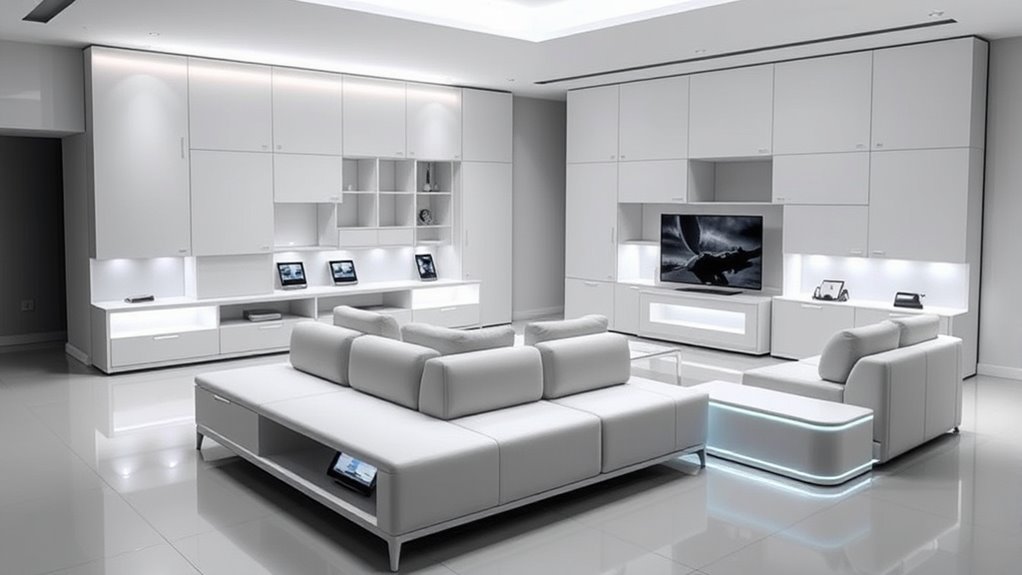
Integrating technology with modular furniture enhances functionality and supports modern work environments. It allows you to create adaptable spaces that meet evolving needs, boosting productivity and collaboration. You can embed charging stations, wireless charging pads, and cable management systems directly into furniture pieces, reducing clutter and improving accessibility. Smart features like adjustable desks with integrated sensors or lighting controls can be easily incorporated, giving you a seamless user experience. Consider these options to upgrade your space:
Enhance your workspace with integrated tech—charging stations, sensors, and smart features for seamless productivity.
- Built-in power outlets and USB ports for easy device charging
- Wireless charging surfaces for convenience
- Embedded sensors for lighting, temperature, and occupancy control
Future Trends in Modular Furniture Innovation
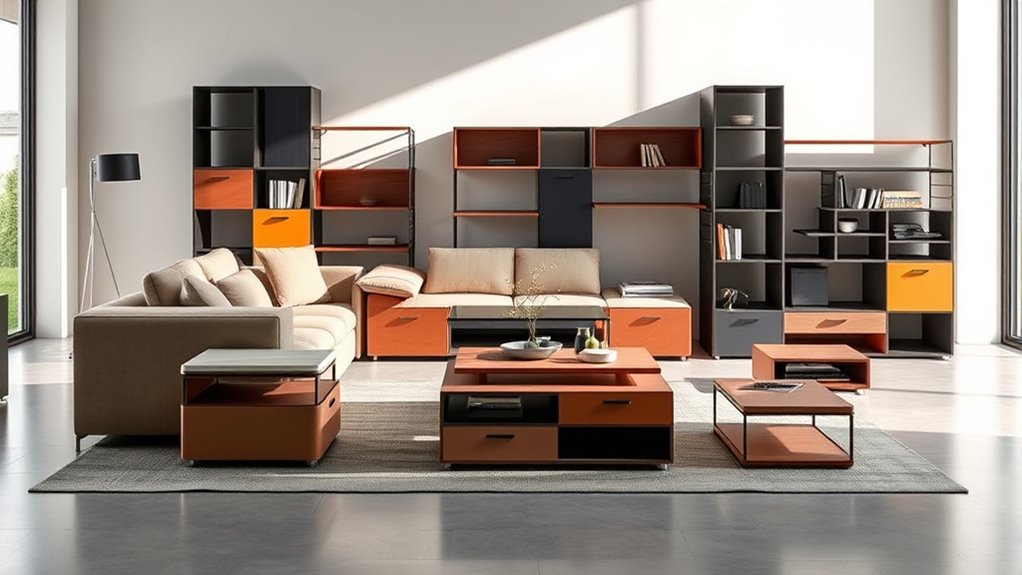
As technology continues to advance, future trends in modular furniture innovation will focus on creating smarter, more adaptable workspaces. You’ll see furniture embedded with sensors that monitor usage and environmental conditions, helping optimize space and comfort. Expect materials that are sustainable, lightweight, and easy to reconfigure, making it simple to adapt your workspace on demand. Integration with smart home and office systems will allow furniture to connect seamlessly with your devices, enabling automation and personalized settings. Modular designs will become more versatile, supporting hybrid work models by allowing quick reorganization for different activities. Additionally, furniture will incorporate augmented reality to assist in planning layouts. These innovations will give you more flexible, efficient, and personalized environments to enhance productivity and well-being.
Frequently Asked Questions
How Is Modular Furniture Maintenance Different From Traditional Furniture?
When you compare maintenance of modular furniture to traditional pieces, you’ll notice it’s more straightforward. Modular systems allow you to replace or upgrade individual components instead of the whole unit, saving time and effort. You can easily access and service parts without dismantling entire furniture sets. This flexibility reduces long-term costs and effort, making maintenance more efficient, convenient, and adaptable to your changing needs.
Can Modular Systems Be Customized for Specific Industry Needs?
You can customize modular systems to meet specific industry needs by selecting components that suit your workspace requirements. These systems are designed for flexibility, allowing you to modify, add, or rearrange modules easily. Whether you need specialized storage, seating, or work surfaces, customization guarantees the furniture aligns with your operational demands. This adaptability helps optimize your space, improve efficiency, and create a tailored environment for your industry.
What Are the Environmental Impacts of Modular Furniture Manufacturing?
The environmental impacts of modular furniture manufacturing include resource consumption, waste generation, and energy use. You might notice that producing modular pieces often requires less material, reducing waste. Additionally, since these systems are designed for reuse and reconfiguration, they can lower the need for new furniture, cutting down on landfill waste. However, manufacturing processes still consume energy and raw materials, so choosing eco-friendly materials and practices helps minimize environmental harm.
How Does Modular Furniture Accommodate Future Technological Upgrades?
You’re wondering how modular furniture can handle future tech upgrades. Modular systems let you easily swap or add components, so as new technology emerges, you can update your furniture without replacing everything. This adaptability minimizes waste and saves costs. You simply detach outdated parts and install newer ones, ensuring your workspace stays current. It’s a smart way to stay flexible and future-proof your environment without the hassle of complete redesigns.
Are There Ergonomic Considerations Unique to Modular Furniture Design?
Ergonomic considerations are essential in modular furniture design because you want to guarantee comfort and health. You should prioritize adjustable features like height, armrests, and lumbar support so you can customize your workspace. Additionally, you need to think about proper posture, easy reach to tools, and sufficient space for movement. These factors help you work efficiently while reducing strain, making ergonomic design a key element in creating a functional, adaptable environment.
Conclusion
Think of modular furniture as a chameleon in your space, adapting effortlessly to your changing needs. Just like a skilled artist, you can reshape and redefine your environment with these versatile pieces, creating a masterpiece that reflects your lifestyle. Embrace this dynamic approach, and your space becomes a living canvas—always ready for a new chapter. With modular systems, you hold the brush to design your perfect, flexible sanctuary.




